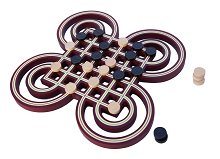Rules of Alquerque
The game of Alquerque is an ancient game, the forerunner of draughts. A multitude of variants of Alquerque boards have been found indicating the existence of a whole family of Alquerque games and variations. Since it is not played today and because no definitive account of the rules is known, the following rules are conjecture based upon a partial description in the Alfonso manuscript of 1283.
See also: Ancient & Historical Board Games.
Alquerque based on the Alfonso Manuscript
Equipment
The game of Alquerque is played on a special board of 5 x 5 points with lines between them to indicate allowed moves. To draw a board is easy. First draw a 5 x 5 orthogonal grid. The draw two diagonal lines - from each corner to the opposite corner. Finally draw four diagonal lines in the form of a square that connects the midpoints of each side. Alquerque is played with 12 black pieces and 12 white pieces in a similar way to Draughts (Checkers). The pieces could be any shape but typically are counters or disks.
Preparation and Objective
Toss a coin to decide who plays first. Playing first is generally thought to be disadvantageous because of the lack of options. The player playing black pieces places them on the 10 points of the nearest 2 rows plus the 2 rightmost points on the middle row as the player looks at it. The other player sets the white pieces up in exactly the same way. This leaves only the middle point without a piece upon it. The objective of the game is to take all of the opponent's pieces or to produce a position such that the opponent is unable to move.
Play
Players take turns to move one of their pieces. A piece may only move along the lines inscribed upon the board. For each turn a piece makes either a capturing move or an ordinary move. Whenever a piece has an opponent's piece adjacent to it and the point immediately beyond the opponent's piece is vacant, the opponent's piece can be captured. A piece is taken by simply hopping over it into the vacant point beyond and removing it from the board. Unlike an ordinary move, a capturing move can consist of several such hops - if a piece takes an opponent's piece and the new position allows it to take another piece, then it can do so straight away. The move finishes when the position of the capturing piece no longer allows it to taken any more pieces or the player could make another capture but decides not to. An ordinary move is made by simply moving a piece along a line to an adjacent point.
Finishing
The game is won by the player who first manages to take all his opponent's pieces or by the player who has more pieces when it becomes apparent that no more pieces will be taken. Alternatively, a player can win by rendering the other player unable to move. A draw occurs by agreement at any point during the game. If it becomes apparent that no more pieces will be taken and both players have the same number of pieces left, a draw is agreed. Draws are very common.
Variant
To make the game more interesting, participants might like to try the following additional rules proposed by R. C. Bell in his "Board and Table Games from Many Civilisations". Primarily this adapts the compulsory capture and the "forward only" rules from Draughts.
- If the player has the opportunity to capture one or more of the opponent's pieces, then the player must do so. If a piece takes an opponent's piece and the new position allows it to take another piece, then it must do so straight away.
- If a player notices that the opponent failed to capture when the option was open, that player can "huff" the offending piece before the next move is made, and it is removed from the board.
- If more than one piece can capture, then the player is entirely free to choose which of those pieces to move. Likewise, if a capturing piece is able to capture in more than one direction, the player is free to choose which direction to move in. i.e. it is not compulsory to move the piece or take the route that will result in the maximum number of captures.
- A piece cannot move backwards, only sideways, forwards or diagonally forwards. A piece that has reached the final row may only move by capturing sideways.
- No piece may return to a point that is has occupied previously.
These rules are provided by Masters Traditional Games, an Internet shop selling quality traditional games, pub games and unusual games. For general information or for copying and copyright, see our Rules Information page.
Our rules are comprehensive instructions for friendly play. If in doubt, always abide by locally-played or house rules.
Copyright James Masters, 2025. All rights reserved.









































